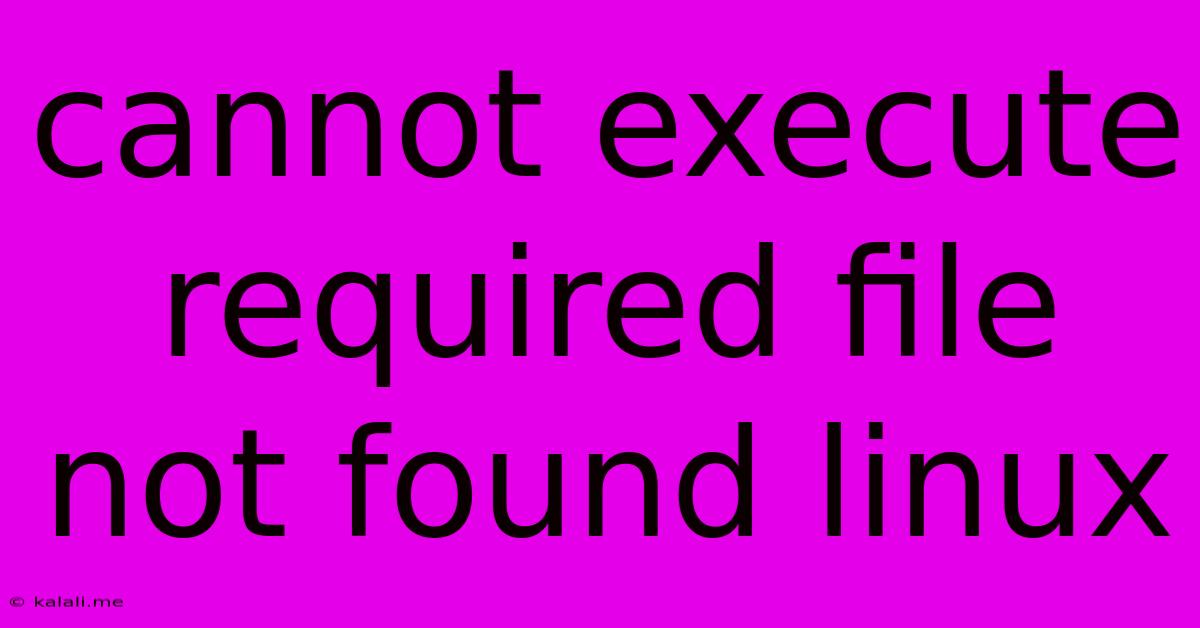Cannot Execute Required File Not Found Linux
Kalali
Jun 07, 2025 · 3 min read

Table of Contents
Cannot Execute Required File Not Found Linux: Troubleshooting Guide
The dreaded "cannot execute required file not found" error in Linux is a common frustration for users, especially those new to the command line. This error message usually indicates a problem with file permissions, file location, or the file's executability. This guide will walk you through troubleshooting this issue and getting your programs running smoothly again.
What this error means: This error signifies that the Linux system can't find the specific file it needs to execute a command or run a program. This could be due to a misspelled filename, the file being in the wrong directory, or the file simply not existing. It's a common problem with various causes, each requiring a slightly different approach to solve.
Common Causes and Solutions:
Here's a breakdown of the most frequent causes of this error, along with step-by-step instructions to fix them:
1. Incorrect File Path
- Problem: You've typed the file path incorrectly, or the file isn't located where you think it is.
- Solution:
- Double-check your spelling: Carefully review the command you entered. Even a single typo can cause this error.
- Use absolute paths: Instead of relative paths (e.g.,
./myprogram), use absolute paths (e.g.,/home/user/myprogram). This eliminates ambiguity about the file's location. - Use
locateorfind: If you're unsure of the file's exact location, use thelocatecommand (if it's indexed) orfindcommand to search for it. For example:locate myprogramorfind / -name "myprogram"(the latter is resource-intensive and should be used cautiously). - Check for hidden files: Ensure you aren't accidentally omitting a leading dot (
.) for hidden files.
2. Incorrect File Permissions
- Problem: The file exists, but you don't have the necessary permissions to execute it.
- Solution:
- Check permissions using
ls -l: This command shows file permissions. Look for the execute permissions (x) for the owner, group, and others. For example:ls -l /path/to/your/file - Change permissions using
chmod: If the execute permission is missing, use thechmodcommand to add it. For example, to give execute permission to the owner:chmod +x /path/to/your/file - Run as root (with caution): If you're still having trouble, try running the command with
sudo(superuser do). However, this should be a last resort and only used if you understand the security implications.
- Check permissions using
3. File Doesn't Exist
- Problem: The file simply isn't present in the specified location. This could be due to deletion, incomplete download, or a simple misspelling.
- Solution:
- Verify file existence: Double-check the file's location. Use a file manager or the command line to confirm its presence.
- Reinstall or redownload: If the file is supposed to be present (e.g., a program installation), try reinstalling or redownloading it.
- Check for typos in the filename: Be absolutely certain that you've spelled the filename correctly.
4. Environment Variables
- Problem: The script or program relies on environment variables that are not correctly set.
- Solution:
- Check environment variables: Use the
printenvcommand to see your current environment variables. - Set environment variables: If necessary, set the required environment variables using
export. For example:export MY_VARIABLE=my_value. You may need to add this to your shell configuration files (e.g.,.bashrc,.zshrc) for permanent changes.
- Check environment variables: Use the
5. Dependencies
- Problem: The program may rely on other libraries or files that are missing or corrupted.
- Solution:
- Check package manager: If the program was installed via a package manager (like apt, yum, or pacman), use the package manager to ensure all dependencies are installed and updated.
- Review program documentation: Consult the program's documentation for details on any necessary dependencies.
By systematically investigating these common causes and applying the provided solutions, you should be able to resolve the "cannot execute required file not found" error in Linux and get your programs running again. Remember to always back up important data before making significant system changes.
Latest Posts
Latest Posts
-
What Angle To Join 3 Right Isosceles Triangles
Jun 07, 2025
-
How To Make A Speaker Louder
Jun 07, 2025
-
Blob Is Not A Valid Utf 8 String
Jun 07, 2025
-
Is A Piano A Percussion Instrument
Jun 07, 2025
-
Waht Dose Banging On Someone In The Hood Mean
Jun 07, 2025
Related Post
Thank you for visiting our website which covers about Cannot Execute Required File Not Found Linux . We hope the information provided has been useful to you. Feel free to contact us if you have any questions or need further assistance. See you next time and don't miss to bookmark.